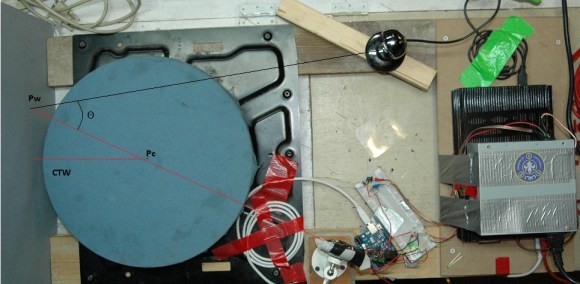
The LVL1 Hackerspace held a hackathon back in June and this is one of the projects that was created in that 24-hour period. It’s a 3D scanner made from leftover parts. The image gives you an idea of the math used in the image processing. It shows the angular relations between the laser diode, the subject being scanned, and the webcam doing the scanning.
The webcam is of rather low quality and one way to quickly improve the output would be to replace it with a better one. But because the rules said they had to use only materials from the parts bin it worked out just fine. The other issue that came into play was the there were no LCD monitors available for use in the project. Because of that they decided to make the device controllable over the network. On the right you can see a power supply taped to the top of a car computer. It connects to the laser (pulled out of a barcode scanner which produces a line of red light) and the turntable. A Python script does all of the image processing, assembling each slice of the scan into both an animated GIF and an OBJ file.
[Thanks Nathan]















Oh! The “car computer” is a CarPC, not an ECU (emissions control unit), I followed the link just to see how they would have used an ECU in the build…
But in no way did I intend to belittle their accomplishment with the previous comment.
I too was baffled by this detail. Thanks Ren!
I agree that this was a great accomplishment!
Also… ECU is Engine Control Unit (giyf)
I initially thought it was related to the Rome built in a day; SFM project.
There seems to be a number of these 3D scanner projects on the net with software related to them so I’m curious why they didn’t just use some already available code. I’m looking at one right now that looks virtually identical to what they did. It took me all of 30 seconds to find it. Is everything out there so horrible that they managed to do a better job than everyone else has for years now in less than 24 hours?
These guys must be really good!
This build was a part of the 24 hour hackathon at lvl1 and the rules didn’t allow for previously written code, thus it all had to be done during said 24-hour period.
Didn’t you say the PC was running Debian? That is previously written code. I know you didn’t write Debian in less than 24 hours!
“Didn’t you say the PC was running Debian?”
Huh? I didn’t say anything to that effect. I didn’t write that article, only the comment you just replied to.
“That is previously written code.”
Haha well yes, but I think you knew what I meant was that they had to write the 3d scanner code themselves and couldn’t just copy and paste another’s code, be done, and call it their hack. Course they made use of libraries and such so I guess you could call me out on that and be correct.
My point was that yes, there are nicer 3d scanning projects out there, no they weren’t arrogant enough to think they could have done a better job than everyone else out there in just 24 hours, and it was just a self imposed limit to keep the contest fun and friendly.
For me it would have been enough of a hack to assemble a 3D scanner out of the materials on hand. I just find the further code limitation a bit of a stretch. But hey they pulled that off too so I suppose it is an added bonus.
Well, if you go this way, they probably didn’t build the PC motherboard and I’m kind of sure they didn’t engrave the CPU by hand on a chunk of wafer :o)
The frontier is hard to set, but here is one of my all time favorite quotes that may make you reconsider your point of view:
“In order to make an apple pie from scratch, you must first create the universe”
– Carl Sagan
Yeah and when Sagan was saying billions, and billions, that was him counting out the grains of flour he needed. That is why we never tasted any Sagan apple pie.
Thanks, but I’ll stick with my point of view. Assembling the project should have been enough.